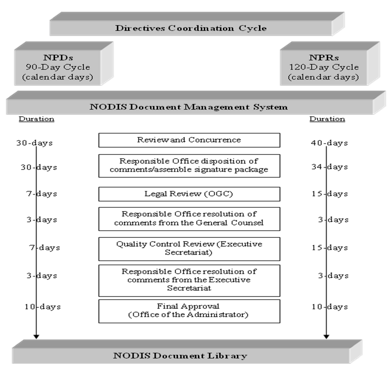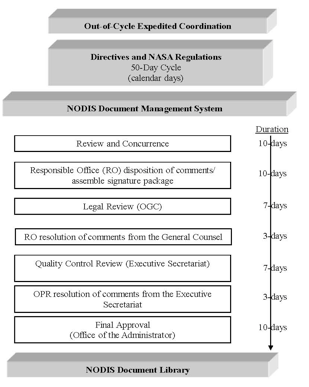Chapter 1. NASA Directives
1.1 Overview
1.1.1 A NASA directive is a document that formally prescribes requirements derived from law, the President, Federal regulation, the NASA Administrator, or other senior NASA officials. NASA directives can apply to all NASA activities or to a single NASA Center. NASA directives: (1) Establish policies, procedural requirements, and organizations; (2) Define purpose; (3) Grant authority to accomplish a task; and (4) Assign responsibilities.
1.1.2 Responsible Offices develop, coordinate, and promulgate NASA directives in accordance with this NPR to ensure that NASA directives:
a. Are necessary for the fulfillment of NASA's mission.
b. Are evaluated by all impacted or interested parties in draft form before issuance and that feedback is provided for comments received.
c. Are reviewed in draft form to reduce the potential for unintended technical, financial, or legal risks.
d. Are available and easily accessible or retrievable by all affected or interested parties.
e. Include an explanation of how the requirements in the directive will be verified for compliance.
1.2 General Provisions Governing NASA Directives
1.2.1 NASA Directives are published in the NODIS Library at http://nodis3.gsfc.nasa.gov/.
1.2.1.1 Agency-level directives include NPDs that state the Agency's policies, NPRs that provide detailed procedural requirements to implement policy, and NIDs that provide an immediate, short-term statement of the Agency's policies or procedural requirements.
1.2.1.2 The Administrator approves all NPDs. Center Directors, or designees, approve all Center directives (e.g., CPDs, CPRs, and CIDs).
1.2.1.3 The signatory authority for NPRs and NIDs is either the Official-in-Charge of the Headquarters organization originating the NPR/NID or the Administrator.
1.2.2 NASA directives may apply to JPL (an FFRDC), other contractors, recipients of grants or cooperative agreements, and parties to other agreements only to the extent specified or referenced in the applicable contract, grant, or agreement. When NASA directives are applied to JPL, other contractors, recipients of grants or cooperative agreements, or parties to other agreements, the contract, grant, or agreement should specify which specific requirements from directives apply. Conversely, requirements directed toward civil servants and contractors should be clearly delineated within directives so that contracts, grants, or agreements can appropriately identify which requirements apply. See notes under paragraphs 2.13.2 and 2.14.2f for delineating examples.
1.2.3 Approved NASA directives are in effect for a maximum of five years. However, revisions can be made whenever a change is warranted.
Note: Updates to change sections of an NPR can be coordinated in NODIS if the entire directive does not need to be revised. These updates will be recorded in the NPR's Change Log. There will be an assignment of a new five-year expiration date upon the completion of the changes.
1.2.4 NASA Centers may issue directives when no Agency-level directive exists that provides the required policy or instruction, when an Agency-level directive does not provide adequate policy or instruction, or when a situation is unique to a particular Center.
Note: It is at the discretion of Center management to determine whether Agency-level directives are sufficient or if more specific requirements are needed by the Center.
1.2.5 Requests for Relief (e.g., waivers, deviations, and tailoring) to Agency-level directives may be requested. See requirements for waiver requests in paragraph 4.2.
1.2.6 NPDs and NPRs are coordinated in the NODIS Document Management System (DMS) in accordance with an established monthly directives review cycle schedule that is accessible in the DMS. The coordination time for NPDs is no more than 90 calendar days. The coordination time for NPRs is no more than 120 calendar days. See the Directives Coordination Cycle in Figure 1-1.
Note 1: The coordination timeline starts on the day the official review commences. The Responsible Office may request up to three 30-day extensions to the coordination cycle. If the third 30-day extension has lapsed, the Responsible Office may request a waiver to receive another extension.
Note 2: Directives in coordination are tracked in the Headquarters Action Tracking System (HATS) and will appear overdue if submitted after the suspense date. Directives that languish in NODIS review with no action taken to respond by the suspense date, may be withdrawn by MSD if extensions are not requested.

Figure 1-1, Directives Coordination Cycle
1.2.7 However, NPDs and NPRs may be coordinated any time during the month on an out-of-cycle schedule for an expedited review in the NODIS DMS as long as the changes are minor and/or small portions of the document are being changed. Timelines for coordination are provided by the Responsible Office. Responsible Offices requesting out-of-cycle expedited reviews of NPDs and NPRs shall include the following in the request:
a. Purpose/rationale.
b. Internal or external requirement driving the Agency to publish requirements.
c. Date by which NPD or NPR needs to be published.
c. Timeline for coordination to include the dates for review, disposition, legal review, quality review, and Administrator's office approval.
Note 1: The minimum timeline for coordination is no less than 50 calendar days. See the Out-of-cycle Coordination Cycle in Figure 1-2.
Note 2: Extensions may be requested directly with the responsible office who can determine if a NODIS extension is necessary in accordance with Note 1 under paragraph 1.2.6.

Figure 1-2, Out-of-Cycle Coordination Cycle
1.3 Description and Hierarchy of NASA Directives
1.3.1 In the event of a conflict among the top-level directives, the information provided in the highest ranking directive takes precedence.
1.3.2 In the event of a conflict among the top-level directives and one or more NPDs and CPDs and/or NPRs and CPRs, the information provided in the top-level directive(s) takes precedence.
1.3.3 In the event of a conflict between an NID, NPD, and an NPR, the information provided in the NID takes precedence.
Note: NIDs are included in the hierarchy at the same level of the directive it is intended to replace (i.e., an NID that is published in place of an NPD or NPR is included in the hierarchy at the level of either directive type).
1.3.4 In the event of a conflict between an NPD and an NPR with a Center-level directive, the information provided in the NPD or NPR takes precedence.
1.3.5 In the event of a conflict between a CPD and a CPR, the information provided in the CPD takes precedence.
1.3.6 In the event of a conflict between two or more equally ranking documents, the directive assigned to the office that is responsible for the function or program takes precedence.
Note 1: Attachment D of NPD 1400.1 establishes the order of flow and precedence and displays the hierarchical relationship between directives and NASA internal requirement documents.
Note 2: Readers may report conflicts to the Directives Manager to initiate resolution. See paragraph 2.13.1f.
DISTRIBUTION:
NODIS
This Document is Obsolete and Is No Longer Used.
Check the NODIS Library to access the current version:
http://nodis3.gsfc.nasa.gov
![[NASA Logo]](../Images/nasaball.gif)

